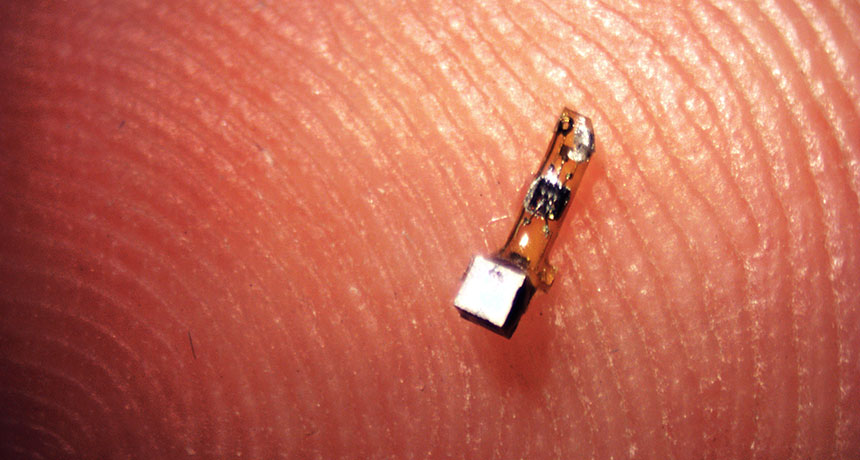‘Neural dust’ can listen to body’s electrical signals

A small device with a heart of crystal can eavesdrop on muscles and nerves, scientists report August 3 in Neuron. Called neural dust, the device is wireless and needs no batteries, appealing attributes for scientists seeking better ways to monitor and influence the body and brain.
“It’s certainly promising,” says electrical engineer Khalil Najafi of the University of Michigan in Ann Arbor. “They have a system that operates, and operates well.”
Michel Maharbiz of the University of California, Berkeley and colleagues presented their neural dust idea in 2013. But the paper in Neuron represents the first time the system has been used in animals. Neural dust detected activity when researchers artificially stimulated rats’ sciatic nerves and muscles.
Unlike other devices that rely on electromagnetic waves, neural dust is powered by ultrasound. When hit with ultrasound generated by a source outside the body, a specialized crystal begins to vibrate. This mechanical motion powers the system, allowing electrodes to pick up electrical activity. This activity can then change ultrasound signals that travel back to the source, offering a readout in a way that’s similar to a sonar measurement.
Neural dust devices may help scientists avoid some of the problems with current implants, such as a limited life span. Implantable devices can falter in the brain’s hostile environment. “It’s like throwing a piece of electronics in the ocean and wanting it to run for 20 years,” Maharbiz says. “Eventually things start to degrade and break down.” But having a simple, small device may increase the life span of such implants — although Maharbiz and colleagues don’t yet know how long their system could last.
What’s more, the brain can mount a defense against the foreign object, which can result in thick tissue surrounding the implant. Smaller systems damage the brain less. At over 2 millimeters long and just under 1 millimeter wide, a particle of the neural dust described in the paper is larger than most actual specks of dust. But the system is still shrinking. “There’s a lot of room here to just really push it, and that’s what excites us,” Maharbiz says. “You can keep getting smaller and smaller and smaller.”
Neural dust could ultimately be used to detect different sorts of data in the body, not just electrical activity, Maharbiz says. The device could be tweaked to sense temperature, pressure, oxygen or pH.
Najafi cautions that it remains to be seen whether the system will prove useful for listening to nerve cell behavior inside the brain. The system would need to include many different pieces of neural dust, and it’s not clear how effective that would be. “It’s a lot harder than the notion of dust implies,” he says.